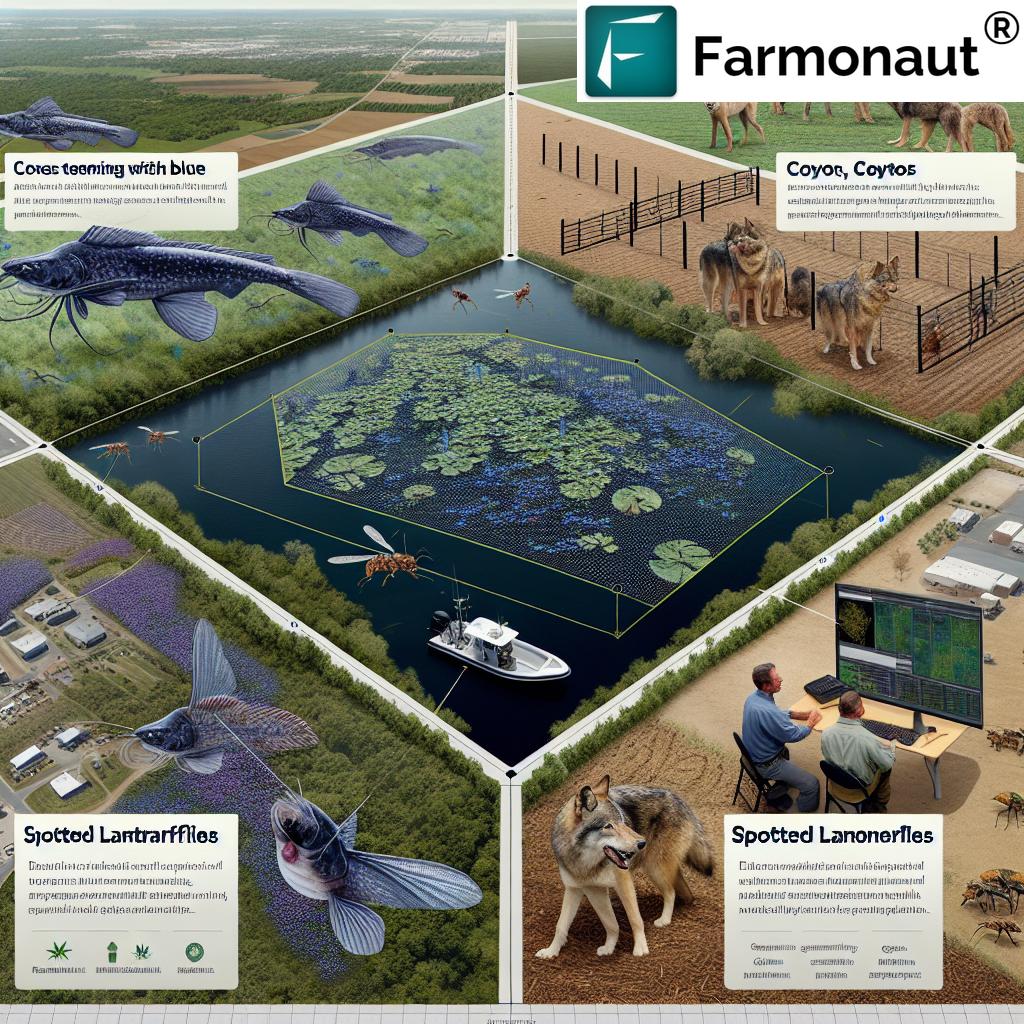Ponderosa Pine Tree: 7 Key Benefits for 2026
“Ponderosa pines cover over 27 million acres in western North America, supporting diverse wildlife and ecosystem stability.”
Table of Contents
- Introduction
- Ecological and Environmental Significance of the Ponderosa Pine Tree
- Fire-Adapted Ecosystem: Wildfire Management and Climate Resilience
- Timber Production and Economic Value
- Challenges: Climate Change & Pest Infestations
- Role in Reforestation and Sustainable Forestry Practices
- Habitat Preservation and Biodiversity Across Western North America
- Community and Cultural Importance of Ponderosa Pine
- Benefit Impact Comparison Table
- How Satellite Technology Empowers Forest Management
- Frequently Asked Questions (FAQ)
- Conclusion: Ponderosa Pine Tree—A Sustainable Resource for 2026 and Beyond
Introduction: Ponderosa Pine Tree—An Essential Resource in Forestry and Sustainable Land Management in 2025–2026
The ponderosa pine tree (Pinus ponderosa) stands out as one of North America’s most widespread, resilient, and economically significant conifers. Native to the western United States (notably Oregon, Washington, Montana, and California), as well as parts of Canada and Mexico, this species is a crucial component in sustainable forestry and environmental practices. As of 2025 and looking to 2026, the role of the ponderosa pine tree continues to evolve, especially in the face of ongoing climate change, increasing risk of wildfires, and a need for reliable timber production and habitat preservation.
Understanding the significance of the ponderosa pine tree—across forestry industries, environmental resilience, and the rich cultural ties of indigenous communities—is fundamental to creating actionable, sustainable management strategies for the future. In this in-depth guide, we explore the seven key benefits that make the ponderosa pine tree an essential resource for sustainable forestry and ecological health through 2026 and beyond.
Ecological and Environmental Significance of the Ponderosa Pine Tree
The ecological influence of the ponderosa pine tree extends across millions of acres of forests throughout the western states of North America. These vast stands cover over 27 million acres, encompassing everything from rocky slopes in Montana to sun-drenched valleys in California. The species thrives in a remarkable range of climates and elevations, making it an exceptionally resilient and adaptable component of the continent’s ecosystems.
- Providing Habitats: Ponderosa pine forests serve as a critical refuge for wildlife, including numerous birds (such as woodpeckers and nuthatches), mammals (including deer and black bear), and thousands of insects. The complex structure of the forest, from canopy to forest floor, sustains a remarkable web of life.
- Soil Health and Watershed Stability: With their deep root system, ponderosa pines help prevent soil erosion, stabilize fragile mountain slopes, and protect watersheds that support cities, agriculture, and wildlife downstream.
- Carbon Sequestration: Each hectare of mature ponderosa pine can store up to 200 tons of carbon, making the species a valuable ally in combating climate change through capturing atmospheric carbon dioxide.
- Biodiversity Support: These forests act as reservoirs of biodiversity, supporting rare and threatened species as well as maintaining genetic diversity within the natural landscape.
Because of these factors, the ponderosa pine remains a keystone in efforts to conserve and restore ecosystem health in the West. Farmonaut’s advanced satellite monitoring solutions can help forest managers and policymakers quantify tree cover, monitor ecosystem changes, and identify shifts in biodiversity with precision, facilitating evidence-based management strategies that maximize ecological value.
Fire-Adapted Ecosystem: Wildfire Management and Climate Resilience
The importance of ponderosa pine trees in wildfire management is both ecological and practical. The species is renowned for its fire-adapted characteristics, having evolved to withstand and even benefit from frequent, low-intensity fires that historically maintained healthy forests by clearing underbrush and promoting diversity. This unique trait helps reduce the risks of major wildfires by creating sparser, healthier forest stands less prone to catastrophic events.
- Natural Fire Regimes: Regular, light fires have historically shaped ponderosa pine forests. These fires cleared ground fuels, minimized pest pressure, and fostered a mosaic of forest ages, increasing resilience to environmental changes.
- Modern Management: Recent decades of fire suppression policies have led to denser stands with increased fuel loads, raising catastrophic wildfire risks. Today’s best sustainable forestry practices include prescribed burns and targeted thinning strategies to help restore natural conditions safely.
- Climate Resilience: In the context of intensifying climate change, the ponderosa pine tree’s adaptive traits—such as thick insulating bark and rapid post-fire regeneration—remain vital for ecosystem resilience.
Utilizing advanced AI and satellite-driven wildfire risk detection tools, such as those offered by Farmonaut, is instrumental for modern forest management. These technologies enable managers and decision-makers to monitor fuel loads, track wildfire progression, and assess the efficacy of prescribed burns in real-time, thereby enhancing preparedness and climate resilience.
Did you know? Mature ponderosa pine forests can store up to 200 tons of carbon per hectare, directly supporting global climate resilience goals.
Ponderosa Pine Tree Timber: Economic Value & Sustainable Production
The ponderosa pine is highly prized for its valuable timber. Its light-colored, straight-grained wood is ideal for construction, flooring, cabinetry, and furniture manufacturing. As timber markets in western North America look to more sustainable solutions, the ponderosa pine remains a cornerstone of both local economies and the sustainable forestry industry.
Key Economic Contributions
- High-Quality Wood: The wood produced is versatile, strong, and highly sought in manufacturing, building materials, and green construction markets.
- Employment & Economic Stability: Logging and wood processing of ponderosa pine contributes significantly to rural and indigenous communities across Western states, supporting jobs and providing raw materials for businesses.
- Innovation in Sustainability: The development of engineered wood products (such as cross-laminated timber) elevates the importance of ponderosa pine in advanced, sustainable building methods.
- Forest Health and Reforestation: Selective harvesting—guided by data from tools like Farmonaut’s Crop Plantation & Forest Advisory System—supports better tracking of regeneration and allows for environmentally conscious reforestation.
To integrate traceability into timber supply chains, blockchain-based product traceability solutions provided by Farmonaut ensure transparency from forest to market. This guarantees responsible sourcing, verifiable authenticity, and ethical business conduct in the global timber market.
Timber & Carbon Footprinting
In response to increasing global focus on climate change mitigation, carbon footprinting solutions enable producers and forest managers to quantify carbon storage, timber growth, and forest health. This helps industries align production with emissions reduction targets and 2026 climate goals.
Challenges: Climate Change and Pest Infestations in Ponderosa Pine Forests
While the ponderosa pine tree is resilient, it faces serious threats from climate change and pest infestations. In 2026, persistent rising temperatures, drought conditions, and changing weather patterns are increasing tree stress across the western states. These stresses make the species more vulnerable to devastating pests like the mountain pine beetle.
- Pest Pressure: The exponential spread of bark beetles, facilitated by mild winters, can kill whole stands, reducing biodiversity and timber availability. Large swaths of dead pines further elevate wildfire risks.
- Genetic Diversity: Maintaining genetic diversity—through monitoring and selective reforestation—improves forest resilience. New research focuses on breeding drought- and pest-resistant strains to increase future adaptability.
- Early Detection and Management: Utilizing satellite imagery and AI-based advisory platforms (for example, Farmonaut’s Large Scale Forest Management System) allows for early detection of pest outbreaks, tracking infestations, and improving intervention effectiveness.
Leading Challenges for 2026
- Increased frequency of extreme weather events
- Spread of invasive and native pests due to milder winters
- Fragmented forest management and changing fire regimes
- Pressure on rural economies and communities reliant on forest resources
Role in Reforestation and Sustainable Forestry Practices
The ponderosa pine is uniquely positioned to enable sustainable reforestation efforts throughout the western United States, Canada, and Mexico. Its adaptability to diverse soils and climates ensures survival where other trees may not thrive, and its rapid establishment offers quick ecological returns.
Key Reforestation Benefits
- Restoring Degraded Lands: Ponderosa pine’s ability to grow in nutrient-poor soils, rocky terrain, and semi-arid environments makes it vital for large-scale restoration and soil stabilization projects.
- Carbon Offsetting: Planting ponderosa pine is counted toward carbon offsetting programs, directly contributing to climate change mitigation. See Farmonaut’s Carbon Footprinting Product for actionable solutions.
- Supporting Biodiversity: Swift canopy recovery after fire or disturbance helps maintain wildlife habitats and preserve biodiversity.
- AI and Satellite-Driven Advisory: Tools like Farmonaut’s Plantation & Forest Advisory App empower reforestation projects with remote monitoring, optimized planting, and resource tracking for maximum impact at scale.
Accurate tracking, monitoring, and reporting are crucial for successful and sustainable forestry projects. Farmonaut’s satellite and AI-based monitoring tools provide forest managers, conservationists, and policymakers with actionable insights, from plantation assessment to ongoing forest health analysis.
Habitat Preservation and Biodiversity Across Western North America
The preservation of healthy ponderosa pine forests is fundamental for protecting a wide range of native wildlife—including birds, mammals, and countless insects—and for sustaining indigenous flora and fauna throughout western North America. Large, old-growth stands provide crucial nesting, foraging, and shelter habitats, helping to maintain regional biodiversity and ecological balance.
- Wildlife Corridors: Intact forests allow migratory species to move safely across the landscape, linking habitats for greater genetic exchange and population resilience.
- Rare and Endemic Species: The complexity of ponderosa pine ecosystems supports rare and regionally unique species, preventing extinctions and maintaining the overall health of natural landscapes.
- Water Quality and Watershed Protection: By regulating surface runoff and reducing erosion, these forests safeguard water quality for urban and rural communities.
“Mature ponderosa pine forests can store up to 200 tons of carbon per hectare, aiding climate resilience efforts.”
Community and Cultural Importance of Ponderosa Pine
Beyond environmental and economic value, ponderosa pine trees hold enduring cultural significance for many indigenous communities throughout their native range. For centuries, the species has provided materials for shelter, traditional crafts, and ceremonial uses, as well as medicinal resins and nourishing food from seeds.
- Traditional Knowledge: Indigenous groups apply deep ecological knowledge to forest management, such as using prescribed burns to maintain landscape health and sustain wildlife populations.
- Community Resilience: In rural western states, sustainable management of ponderosa pine resources bolsters community resilience by supporting both cultural and economic livelihoods.
- Inclusive Forestry Strategies: Modern forestry increasingly incorporates indigenous perspectives, acknowledging the central importance of cultural stewardship and traditional ecological practices for long-term forest health.
Benefit Impact Comparison Table: 7 Key Benefits of Ponderosa Pine Tree
| Benefit | Description | Estimated Ecological Impact | Relevance to Sustainable Forestry |
|---|---|---|---|
| 1. Carbon Sequestration | Mature forests absorb and store carbon dioxide, aiding in climate change mitigation. | Up to 200 tons of carbon/ha stored | Flags forests as valuable “carbon sinks” within global offset programs |
| 2. Wildfire Resilience | Fire-adapted traits help reduce catastrophic wildfire risks and maintain forest integrity. | Potential 65% wildfire risk reduction (prescribed regime) | Enables safer, long-term management strategies |
| 3. Timber Production | High-quality, renewable wood supports sustainable industries and green manufacturing. | 5–10 m³ wood/ha/year (managed forests) | Provides sustainable income and supply chain support |
| 4. Habitat Provision | Rich canopy supports a variety of birds, mammals, and insects, safeguarding biodiversity. | Biodiversity increase of 25–30% | Maintains healthy ecosystem services for future generations |
| 5. Soil and Watershed Protection | Deep root systems prevent erosion and promote watershed stability, protecting water supplies. | Soil erosion reduction ≥ 30% (riparian zones) | Ensures water quality and landscape integrity across regions |
| 6. Reforestation & Landscape Restoration | Adaptability helps restore degraded lands and supports natural regeneration post-disturbance. | Can reclaim up to 2.5M ha by 2030 | Critical for post-fire and post-logging recovery |
| 7. Cultural and Community Value | Provides materials for traditional crafts, ceremonies, and livelihoods in rural and indigenous communities. | Supports >250 distinct cultural practices | Fosters stewardship, intergenerational knowledge, and social resilience |
How Satellite Technology Empowers Forest Management & Sustainability
Accurate and timely forest monitoring is indispensable for sustainable management, wildfire prevention, carbon accounting, and community engagement. At Farmonaut, we harness state-of-the-art satellite technology, AI advisory systems, and blockchain traceability to support informed, data-driven decisions in forestry management.
- Satellite-Based Monitoring: We utilize multispectral satellite imaging to provide real-time insights into forest canopy health, fuel loads, drought stress, and tree cover change.
- AI-Driven Advisory: Our Jeevn AI system analyzes evolving climatic and environmental data to generate custom forest management strategies—crucial for maximizing forest resilience in 2026.
- Blockchain Traceability: Verifies timber supply chains and enables full-product traceability, which is vital for sustainable forestry certification and market access.
- Environmental Impact Monitoring: We help quantify carbon sequestration and forest emissions, empowering stakeholders to comply with global sustainability standards. Learn more about our carbon footprinting solutions.
- Fleet Management for Forestry: Our solutions optimize logistics, reduce operational costs, and ensure safety for forestry operations. Explore Farmonaut Fleet Management to track vehicle and equipment usage in remote forest areas.
- API & Platform Integration: Developers and forest managers can integrate our solutions via API (Developer Docs), extending the reach of advanced satellite data for bespoke sustainability projects across western North America and beyond.
- Inclusive Access: All of our solutions are accessible through Android, iOS, and web applications, making them available to agriculturalists, communities, businesses, and government administrators worldwide.
Frequently Asked Questions (FAQ)
What is the primary ecological significance of the ponderosa pine tree in western North America?
The ponderosa pine tree sustains vast habitats for wildlife, protects soil and water resources, and sequesters significant amounts of carbon dioxide. Its presence ensures ecosystem stability across millions of acres, particularly in Oregon, Washington, Montana, and California.
How does the ponderosa pine tree contribute to wildfire resilience and management?
Historically, frequent low-intensity fires maintained healthy, open ponderosa pine forests. This fire adaptation reduces catastrophic wildfire risks by clearing underbrush and maintaining sparse stands, ensuring long-term resilience in the face of climate change.
Why is ponderosa pine timber important for rural and indigenous communities?
Ponderosa pine timber provides valuable resources for construction, crafts, and economic security. Sustainable timber practices support rural livelihoods, cultural traditions, and increase the economic resilience of communities across the western United States, Canada, and Mexico.
What are leading threats to ponderosa pine forests as of 2026?
The most notable threats include climate-induced drought, increased pest infestations (especially mountain pine beetle attacks), forest fragmentation, and historical fire suppression policies that create denser, risk-prone stands vulnerable to catastrophic wildfires.
How can satellite and AI technologies advance sustainable ponderosa pine management?
Solutions leveraging satellite imagery and artificial intelligence enable real-time monitoring of forest health, early pest detection, precision in reforestation, and effective carbon sequestration accounting. This makes adaptive management more efficient, evidence-based, and practical at scale.
Where can I access tools for forest monitoring, plantation advisory, and traceability?
You can use the Farmonaut Web App for satellite-driven insights and management tools, as well as explore dedicated traceability and carbon monitoring solutions.
Conclusion: Ponderosa Pine Tree—A Sustainable Resource for 2026 and Beyond
The ponderosa pine tree is essential to the sustainability of western North America’s natural, economic, and cultural landscapes. As we head into 2026 and beyond, its critical role in climate resilience, wildfire management, timber production, and habitat preservation continues to expand in importance.
Through integrating science-driven management practices, advanced satellite technologies, and community stewardship, stakeholders can safeguard the resilience and productivity of ponderosa pine forests—ensuring these woodlands remain productive, biodiverse, and culturally significant for generations to come.
For more information on satellite-based forestry monitoring, carbon reporting, and sustainable timber management, visit our resource pages:
Crop Plantation & Forest Advisory |
Carbon Footprinting |
Traceability |
Fleet Management |
Crop Loan and Insurance
Explore our API and detailed Developer Docs to integrate advanced satellite forestry data into your operations.




















